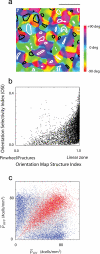On the origin of the functional architecture of the cortex
- PMID: 17330140
- PMCID: PMC1804100
- DOI: 10.1371/journal.pone.0000251
On the origin of the functional architecture of the cortex
Abstract
The basic structure of receptive fields and functional maps in primary visual cortex is established without exposure to normal sensory experience and before the onset of the critical period. How the brain wires these circuits in the early stages of development remains unknown. Possible explanations include activity-dependent mechanisms driven by spontaneous activity in the retina and thalamus, and molecular guidance orchestrating thalamo-cortical connections on a fine spatial scale. Here I propose an alternative hypothesis: the blueprint for receptive fields, feature maps, and their inter-relationships may reside in the layout of the retinal ganglion cell mosaics along with a simple statistical connectivity scheme dictating the wiring between thalamus and cortex. The model is shown to account for a number of experimental findings, including the relationship between retinotopy, orientation maps, spatial frequency maps and cytochrome oxidase patches. The theory's simplicity, explanatory and predictive power makes it a serious candidate for the origin of the functional architecture of primary visual cortex.
Conflict of interest statement
Figures









Similar articles
-
Circuitry Underlying Experience-Dependent Plasticity in the Mouse Visual System.Neuron. 2020 Apr 8;106(1):21-36. doi: 10.1016/j.neuron.2020.01.031. Neuron. 2020. PMID: 32272065 Free PMC article. Review.
-
Interlayer Repulsion of Retinal Ganglion Cell Mosaics Regulates Spatial Organization of Functional Maps in the Visual Cortex.J Neurosci. 2017 Dec 13;37(50):12141-12152. doi: 10.1523/JNEUROSCI.1873-17.2017. Epub 2017 Nov 7. J Neurosci. 2017. PMID: 29114075 Free PMC article.
-
Diverse receptive fields in the lateral geniculate nucleus during thalamocortical development.Nat Neurosci. 2000 Jun;3(6):608-16. doi: 10.1038/75786. Nat Neurosci. 2000. PMID: 10816318
-
Diversity of Ocular Dominance Patterns in Visual Cortex Originates from Variations in Local Cortical Retinotopy.J Neurosci. 2019 Nov 13;39(46):9145-9163. doi: 10.1523/JNEUROSCI.1151-19.2019. Epub 2019 Sep 26. J Neurosci. 2019. PMID: 31558616 Free PMC article.
-
Functional cell classes and functional architecture in the early visual system of a highly visual rodent.Prog Brain Res. 2005;149:127-45. doi: 10.1016/S0079-6123(05)49010-X. Prog Brain Res. 2005. PMID: 16226581 Review.
Cited by
-
Relationship between the local structure of orientation map and the strength of orientation tuning of neurons in monkey V1: a 2-photon calcium imaging study.J Neurosci. 2013 Oct 16;33(42):16818-27. doi: 10.1523/JNEUROSCI.2209-13.2013. J Neurosci. 2013. PMID: 24133282 Free PMC article.
-
An illusion predicted by V1 population activity implicates cortical topography in shape perception.Nat Neurosci. 2013 Oct;16(10):1477-83. doi: 10.1038/nn.3517. Epub 2013 Sep 15. Nat Neurosci. 2013. PMID: 24036915 Free PMC article. Clinical Trial.
-
Orientation decoding depends on maps, not columns.J Neurosci. 2011 Mar 30;31(13):4792-804. doi: 10.1523/JNEUROSCI.5160-10.2011. J Neurosci. 2011. PMID: 21451017 Free PMC article. Clinical Trial.
-
Generalized spin models for coupled cortical feature maps obtained by coarse graining correlation based synaptic learning rules.J Math Biol. 2012 Dec;65(6-7):1149-86. doi: 10.1007/s00285-011-0484-7. Epub 2011 Nov 19. J Math Biol. 2012. PMID: 22101498
-
Hue and orientation pinwheels in macaque area V4.J Neurophysiol. 2024 Aug 1;132(2):589-615. doi: 10.1152/jn.00366.2023. Epub 2024 Jul 11. J Neurophysiol. 2024. PMID: 38988289 Free PMC article.
References
-
- Mountcastle VB. Modality and Topographic Properties of Single Neurons of Cats Somatic Sensory Cortex. Journal of Neurophysiology. 1957;20:408–434. - PubMed
-
- Mountcastle VB. The columnar organization of the neocortex. Brain. 1997;120:701–722. - PubMed
-
- Grinvald A, Lieke E, Frostig RD, Gilbert CD, Wiesel TN. Functional Architecture of Cortex Revealed by Optical Imaging of Intrinsic Signals. Nature. 1986;324:361–364. - PubMed

